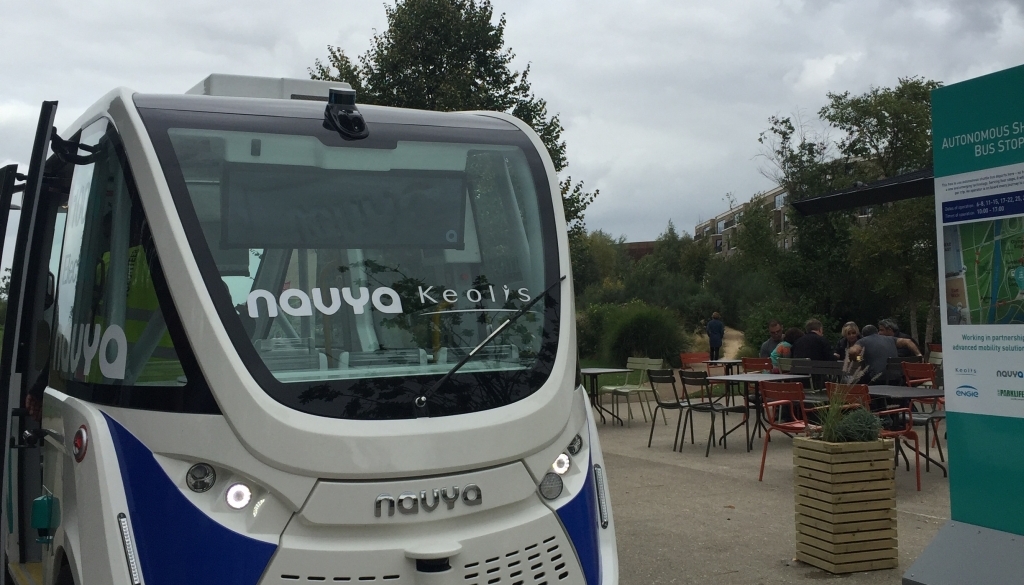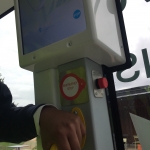My First Experience in a Driverless Car

I recently had the chance to experience a driverless car. Being intrigued by automated technology and what I would make of the experience, I hastily signed up. (Autonomous Shuttle Buses are being developed for University Campuses already.) Here’s the project description as listed on the Queen Elizabeth Olympic Park website:
Developed by Navya, a leading name in the progression of smart and sustainable mobility solutions, and delivered at the Park by Keolis, a leading global transport operator, with the support of Engie, Here East and Our Parklife, the 100% electric vehicles are being tested in response to the increasing demand for smart new mobility solutions for busy urban environments. Keolis and Navya have already been trialling the vehicles in France, USA and Denmark and are looking into the possibility of using them in a range of locations including airports, university campuses and shopping centres.
I came along excited, and open-minded. I wasn’t expecting anything wildly exciting, namely a moderately enhanced version of getting a lift in a milk float. However, I found the event to really bring into relief the psychology of giving up your human agency to an autonomous vehicle. This blog is a short reprieve of what I experienced:
A (silly) video summary:
Driverless vehicles aren’t new – how would this be different?
In one way, driverless vehicles aren’t anything new. We are comfortable with the idea of an autopilot with planes, or the driverless District Light Railway in London. So how would this be different? The technology in play wasn’t wildly sophisticated: a GPS antenna on the top of Here East, plus seven sensors around the vehicle and some strategically placed planters, helped keep the vehicle on its intended route path. (It reminded me of a physical version of BBC Logo from my primary school days). Yet, planes tend to stick to their flight paths, and the District Light Railway doesn’t share its tracks with a mixture of pedestrians, cyclists and runners. Being in a driverless vehicle sharing space with several other agents made me feel nervous!
I was surprised by how difficult it felt to give up my responsibility as a driver, and become a passenger only
This was manifested when, after only about 15 feet of leaving our start point we encountered a meandering cyclist, headphones in, head-down and completely unaware of our 5mph entry into her personal space. There were about ten of us sat in the vehicle intrigued by this scenario, as well as the two project volunteers. We were informed that the vehicle would stop if it came within 3 metres of an object. However, the cyclist came very close to the vehicle before suddenly noticing and veering off. Three of us closest to this potential collision agreed that she was closer than 3 metres.
Indeed, I let out an excitable ‘Sh*t, Sh*t, Sh*t’ when I thought an unlikely 5mph driverless vehicle collision was about to happen.
Other varieties of this scenario included seeing toddlers on their bicycles or scooters framed by the incoming vehicle window, or lone men walking through the park oblivious to our slow arrival into their domain. Something felt sinister about our encroachment, as if we had given up the ability to make the vehicle stop if we needed to and were mere passengers awaiting the worst that might happen. A strange feeling!
Will there be a transition period into becoming perfect passive passengers?


This got me thinking that in the instance of automated vehicles becoming totally mainstream, there will likely be a psychological transition period for us as humans to really be able to make the most of all the free time we suddenly gain. During this transition period we will be the collective embodiment of anxious and/or backseat drivers. Hands will clutch at seats or dashboards as we await the inevitable awful collisions which we have brought upon ourselves by giving up our driver responsibilities. We will constantly point out potential objects up ahead, in a scenario not unlike our irrational behaviour of shouting at the television. Will we have to take tests to be driverless passengers? This is especially true given un-ease at the right-intentioned-ness of a 5mph driverless vehicle, let alone a 60mph version. No doubt we will learn this trick as we have learnt countless others.
What if the cyclist had kept going?
The ethics of driverless cars often come down to a question, such as: ‘If a car were to avoid a plastic bag (because it was programmed to avoid objects) but in doing so, hit and injure or kill a human, who would be responsible?’ Going back to the scenario of the cyclist in our trial got me thinking. This particular driverless vehicle was programmed only to stop if an object came within 3 metres of it. If the cyclist had continued head-down and hit the vehicle that would have been bad for all involved. We were informed that the vehicle had an autonomous horn, but this wasn’t sounded? Why not? The alternative scenario might have been that if something continued into the path of the vehicle, that it not only stop but reverse. On this occasion, this may have been good for the cyclist, but what if something was behind the vehicle? So many decisions to be made, and on this occasion luckily only at 5mph.
Autonomous Shuttle Buses are being developed for University campuses already
You can see that here. It isn’t a far cry to imagine usage spreading from Universities to Colleges to Schools. Overall, my experience proved to me how much I invest in the feeling that ‘someone’ is paying attention to the road and the various shared users of common space when driving. It made me realise that I currently have a much higher innate trust of another human in real-time than a programme developed by humans and then playing out in real-time, but I enjoyed the event and can see how the application will soon feel not that dissimilar to jumping on the District Light Railway, a tram or other routed transport type.
To check out the autonomous shuttle bus for yourself over the next 19 days, check out more details here.



